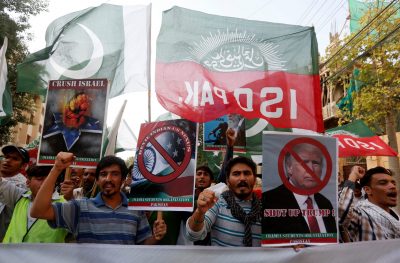28 September 2017
In a speech on 21 August announcing his new US Afghanistan strategy, US President Donald Trump minced no words. ‘We have been paying Pakistan billions and billions of dollars at the same time they are housing the very terrorists that we are fighting’, the US president declared. ‘But that will have to change, and that will change immediately’.
Indeed, in the days preceding and following the speech, Trump administration officials suggested they’re prepared to deepen the pressure on Pakistan to get Islamabad to shut down terror sanctuaries on its soil. US officials have repeatedly issued these demands in recent years. Pakistan has repeatedly refused to budge. The question is whether this time will be different.

Ultimately, the degree of US success will boil down to leverage. Does Washington truly have the ability and influence to compel Pakistan to act against terrorists that threaten Americans in Afghanistan?
Arguments can be made both for and against. Sceptics will contend that leverage won’t work now because it hasn’t worked in the past. In effect, Pakistan has received billions in assistance and loads of weaponry to target terrorists that attack Afghanistan — and yet it has simply continued to patronise them. So why should Pakistan be expected to change its policy now? And especially given Pakistan’s fast-growing partnership with China, which gives Islamabad an incentive not only to ignore Washington’s demands, but also to walk away from Washington altogether?
Others will counter that it’s not that leverage hasn’t worked, it’s just that Washington hasn’t used the right tools. This view calls for going beyond mere bluster and oft-used aid conditionality tactics and escalating to harsher measures. These could include taking the drone war deeper into Pakistan (beyond the tribal belt where the majority of strikes have occurred), placing sanctions and travel bans on Pakistani officials with ties to terrorists, revoking Pakistan’s non-NATO ally status and even declaring Pakistan a state sponsor of terror. The tagline here is simple: why concede failure when not all options have been exhausted?
In truth, both positions are flawed. The China–Pakistan Economic Corridor (CPEC) is solidifying an already strong China–Pakistan relationship. But it’s not as if Islamabad could simply walk away from Washington and waltz into Beijing’s open embrace with no repercussions.
Indeed, China arguably has as strong an interest as the United States in Pakistan shutting down its terror sanctuaries. China needs the high-stakes CPEC to succeed, but CPEC requires stability to succeed. Any terrorist group, including those receiving sanctuary in Pakistan, is potentially destabilising. The September 4 BRICS statement — which marked the first time China signed on to an international declaration condemning the Haqqani Network, Jaish-e-Mohammed and Lashkar-e-Taiba, all of which receive shelter in Pakistan — was likely meant to bring that message home to Pakistan.
Additionally, those arguing for pressuring Pakistan with more escalatory measures underestimate the power of national interests. All nations have interests that die very hard, if at all. Dignitaries from Lord Palmerston to Henry Kissinger have observed that there are no permanent friends or enemies, only permanent interests.
Pakistan has a longstanding interest in pushing back against India, its bitter enemy. The Haqqani Network — which Kabul, New Delhi and Washington have blamed for attacks on Indian targets in Afghanistan — can be used against India in a nation where New Delhi has a deep footprint — one that’s mainly non-security in nature, but nonetheless alarming for Islamabad. For Pakistan, which has a military conventionally inferior to India’s, non-state actors like the Haqqani Network are highly useful assets. Pakistan will be extremely reluctant to turn on them.
Accordingly, the Trump administration will struggle to put the squeeze on Pakistan, no matter how tight its grip.
Perhaps Washington’s best chance of success is to make the costs of Pakistan’s status quo policy prohibitively high. But this would entail implementing highly risky actions (like airstrikes on militant infrastructure) or downright inconceivable measures (like airstrikes on military facilities). Even policies a notch down on the risk scale — sanctioning Pakistani officials, revoking Pakistan’s non-NATO status — could lead to damaging Pakistani retaliations, such as shutdowns of supply routes in Pakistan that serve NATO personnel in Afghanistan.
A more feasible option for Washington may lie in the economic realm. Islamabad has long depended on the IMF to bail out its economy. Some Pakistani economists, citing a growing current account deficit, predict that Islamabad could soon approach the IMF for another bailout. Washington — which wields great influence within the IMF — could lean on the institution to refuse future bailouts until Pakistan takes appropriate counterterrorism measures. Then again, CPEC-related assistance may provide enough of a safety net that being deprived of IMF funds wouldn’t be as damaging now as during pre-CPEC days.
Ultimately, the jury remains out on how much Washington can do to address Pakistan’s terrorist sanctuaries — an enduring tension point in an always volatile relationship.
The article appeared in the East Asia Forum on 28/09/2017
